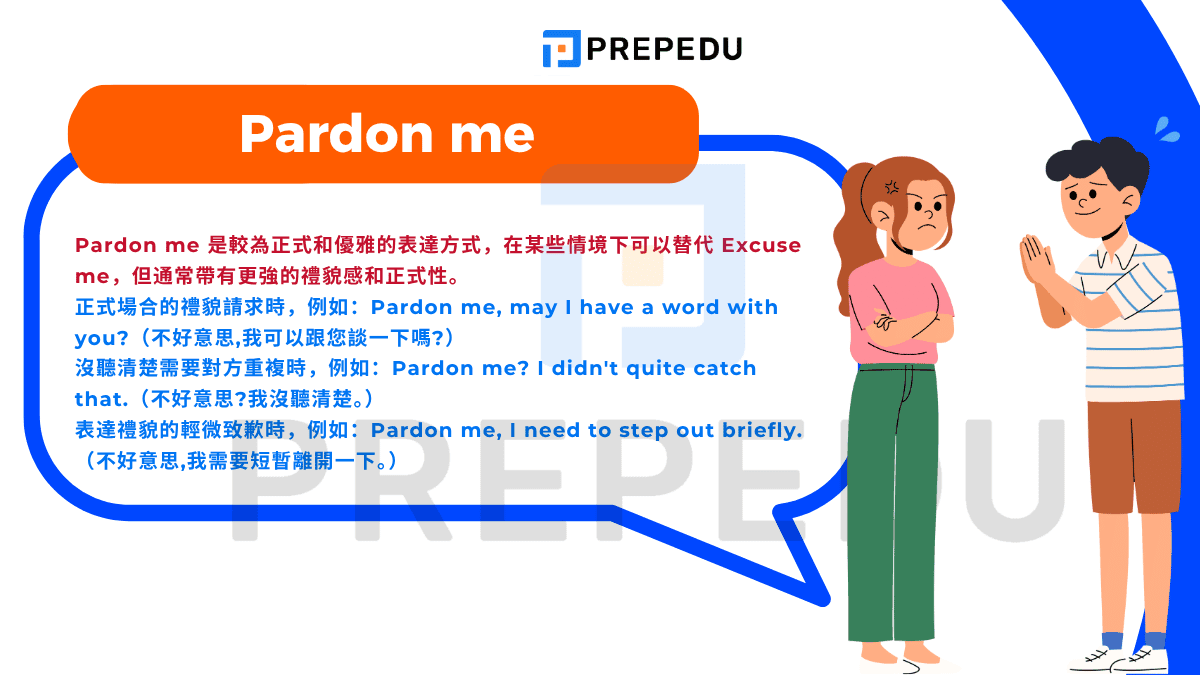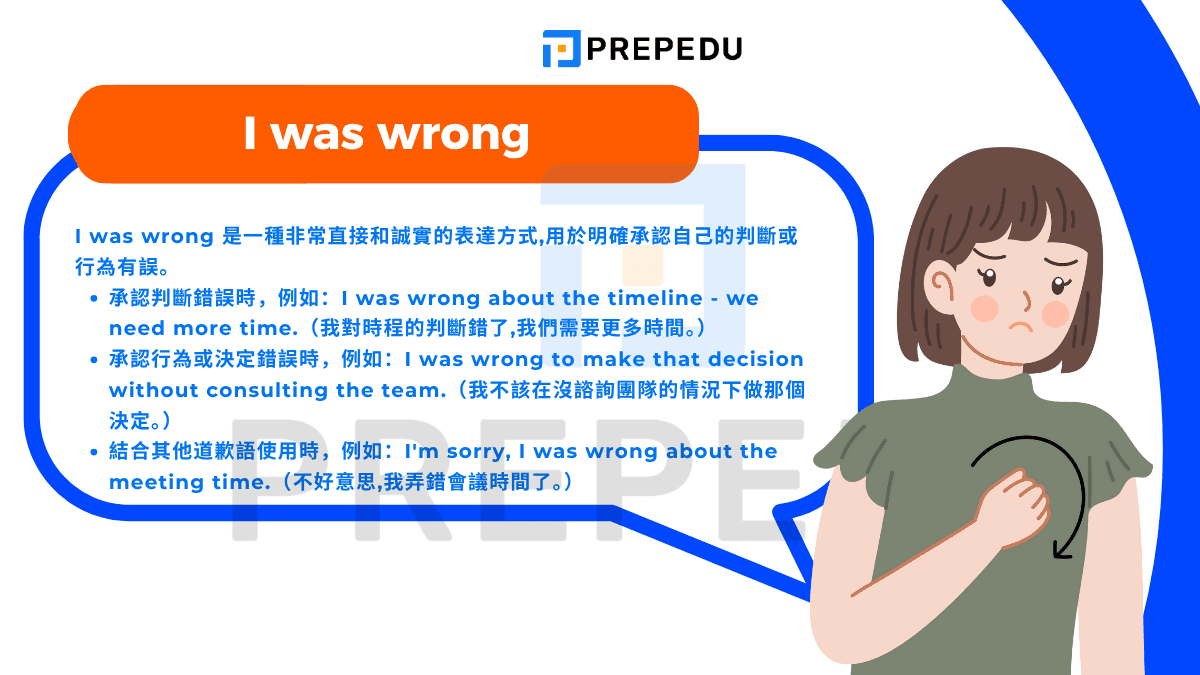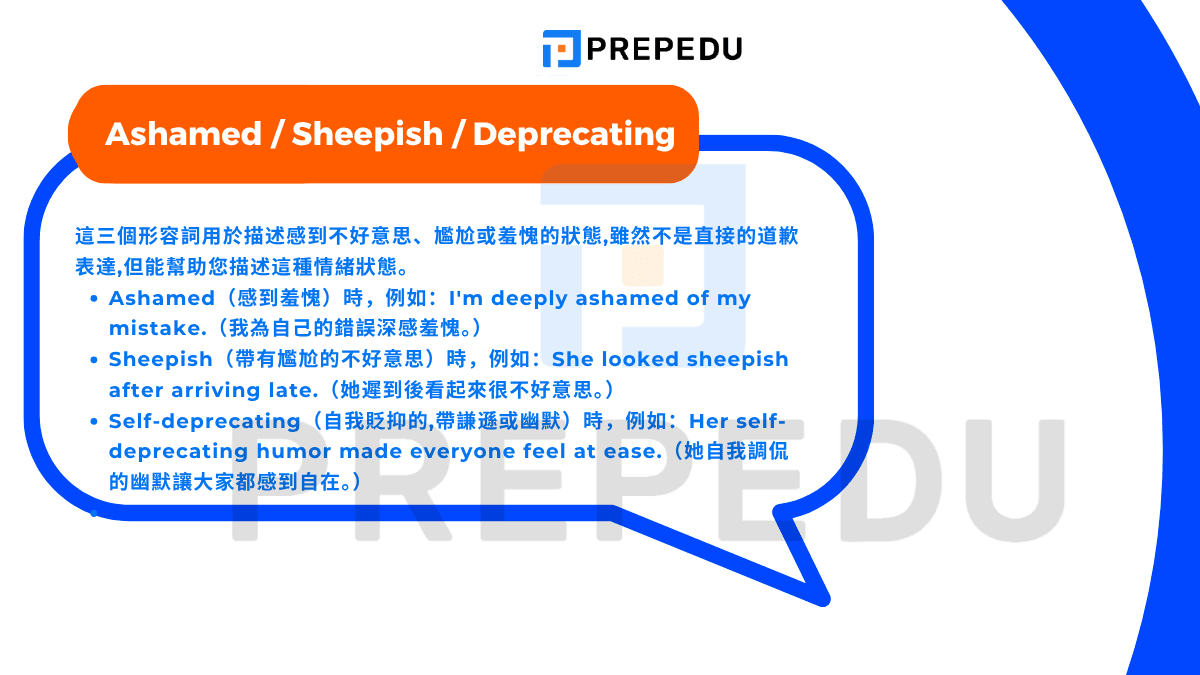「不好意思英文怎麼說?」這是許多英語學習者在生活、工作與社交場合中最常搜尋的問題之一。最直接的回答是 “Excuse me”,但根據情境不同,不好意思還可能對應 “Sorry”、 “Pardon me” 等多種英文表達。如果想真正說得自然,而非逐字翻譯,就必須理解語氣差異、使用場合與背後的文化邏輯。
想像你在擠滿人的電梯裡想要下樓、在開會時不小心打斷別人、或是在路上不經意碰到行人——不同情境下的不好意思英文會呈現截然不同的禮貌程度。這篇由 PREPEDU 精心整理的完整指南,將帶你一次掌握超過 10+ 種最道地的不好意思英文用法,並解析它們在正式、非正式與跨文化溝通中的差異。
透過實用例句、語境分類與母語使用者習慣比較,你將能精準選出最符合場合的道歉或開場語,不再因為表達不當而顯得失禮。閱讀本文後,你不僅能說出正確的不好意思英文,更能真正理解英文禮貌語的細緻層次,讓你的溝通更自然、更專業。
不好意思英文
I. 不好意思英文怎麼說? 10+種不好意思英文表達方式深度解析 在日常生活與工作場合中,「不好意思」這句話可能是華人最常使用的社交用語之一。無論是需要麻煩他人、表達歉意、或是尋求協助,這三個字都能派上用場。然而,當您需要用英文表達相同意思時,是否曾經困惑該使用哪個詞彙才最恰當?本指南將為您深入解析10+種英文表達方式,幫助您在各種情境下都能準確傳達「不好意思」的含義,讓您的英語溝通更加流暢自然。
1. Excuse me Excuse me 是英語中最常見且用途最廣的禮貌用語,對應中文「不好意思」的多種情境。這個表達方式的正式程度適中,適用於幾乎所有日常場合。
情境
範例
引起注意或開啟對話時
Excuse me, could you tell me where the milk section is?(不好意思,請問牛奶區在哪裡?)
Excuse me, is this seat taken?(不好意思,這個位子有人坐嗎?)
Excuse me, may I ask you a quick question?(不好意思,我可以請教你一個小問題嗎?)
需要打斷對話或暫時離開時
Excuse me for a moment, I need to take this call.(不好意思,我需要接個電話。)
Excuse me for interrupting, but I have an urgent matter to discuss.(不好意思打斷一下,但我有緊急事情要討論。)
Excuse me, may I add something here?(不好意思,我可以在這裡補充一點嗎?)
需要通行或輕微身體接觸時
Excuse me, coming through.(不好意思,借過一下。)
Excuse me, could I squeeze past?(不好意思,我可以擠過去嗎?)
Excuse me, I need to get off here.(不好意思,我要在這裡下車。)
Excuse me 是英語中最常見且用途最廣的禮貌用語
2. Sorry Sorry 是表達歉意最直接且普遍的方式,適用於從輕微失誤到較嚴重錯誤的各種情境。這個詞彙的情感強度可以透過語調、前後文字和額外修飾語來調整。
情境
範例
日常小失誤時
Sorry, I didn't see you there.(不好意思,我沒看到你在那裡。)
Sorry, I stepped on your foot.(不好意思,我踩到你的腳了。)
Sorry I'm late, the traffic was terrible.(不好意思我遲到了,交通太糟了。)
表達更深歉意時
I'm so sorry for the inconvenience this has caused.(對於造成的不便,我深感抱歉。)
I'm really sorry I can't make it to your party.(我真的很抱歉無法參加你的派對。)
I'm terribly sorry about the mistake in the report.(對於報告中的錯誤,我深感抱歉。)
道歉並說明原因時
Sorry I missed your call, I was in a meeting.(不好意思我沒接到你的電話,我在開會。)
Sorry for the delay, we had some technical issues.(抱歉延遲了,我們遇到了一些技術問題。)
Sorry I didn't respond sooner, I've been overwhelmed with work.(抱歉沒有早點回覆,我工作太忙了。)
Sorry 是表達歉意最直接且普遍的方式
3. My bad / My fault / My mistake 這三個表達方式都用於直接承認自己的錯誤,但它們的正式程度和使用情境各有不同。
不好意思英文
範例
My bad(最非正式,朋友間使用)
My bad, I thought you said 3 o'clock.(我的錯,我以為你說三點。)
Oh, my bad! I grabbed your drink by mistake.(哦,不好意思!我不小心拿了你的飲料。)
My bad, wrong number.(不好意思,打錯電話了。)
My fault(正式程度居中)
It's my fault we missed the deadline.(我們錯過截止日期是我的錯。)
This confusion is my fault - I should have been clearer.(這個混亂是我的錯,我應該說得更清楚。)
Don't blame the team, it's my fault for not checking properly.(別怪團隊,是我沒有好好檢查的錯。)
My mistake(較正式,適合更正資訊時
My mistake, the meeting is actually at 3 PM, not 2 PM.(我弄錯了,會議其實是下午三點,不是兩點。)
Sorry, my mistake - you were right all along.(不好意思,是我搞錯了,你一直都是對的。)
My mistake, I sent you the wrong file.(不好意思,我傳錯檔案給你了。)
My bad / My fault / My mistake 的用法
4. Pardon me Pardon me 是較為正式和優雅的表達方式,在某些情境下可以替代 Excuse me,但通常帶有更強的禮貌感和正式性。
情境
範例
正式場合的禮貌請求
Pardon me, may I have a word with you?(不好意思,我可以跟您談一下嗎?)
Pardon me for interrupting your conversation.(不好意思打斷你們的談話。)
Pardon me, would you mind repeating that?(不好意思,您可以再說一次嗎?)
沒聽清楚需要對方重複時
Pardon me? I didn't quite catch that.(不好意思?我沒聽清楚。)
I beg your pardon, could you speak a bit louder?(不好意思,您可以說大聲一點嗎?)
Pardon me, what was the last part again?(不好意思,最後那部分可以再說一次嗎?)
表達禮貌的輕微致歉
Pardon me for being late to the meeting.(不好意思會議遲到了。)
Pardon me, I need to step out briefly.(不好意思,我需要短暫離開一下。)
Pardon me 是較為正式和優雅的表達方式,在某些情境下可以替代 Excuse me
5. I apologize / My apologies I apologize 和 My apologies 代表了英語中最正式的道歉方式,通常用於嚴肅的情境或需要表達深切歉意的場合。
情境
範例
正式的書面道歉
I apologize for the inconvenience this may have caused.(對於可能造成的不便,我深表歉意。)
I sincerely apologize for the error in the invoice.(對於發票上的錯誤,我誠摯道歉。)
I apologize for the delayed response to your inquiry.(對於延遲回覆您的詢問,我深感抱歉。)
具體說明道歉原因
I apologize for missing the deadline - it won't happen again.(我為錯過截止日期道歉,這不會再發生了。)
I apologize for the confusion caused by my previous email.(我為先前郵件造成的混淆道歉。)
I apologize for not informing you sooner about this change.(我為沒有更早通知您這項變更道歉。)
My apologies(稍微不那麼正式但仍禮貌)
My apologies for any misunderstanding.(對於任何誤會,我深感抱歉。)
My apologies, I should have checked with you first.(不好意思,我應該先跟您確認的。)
Please accept my apologies for the oversight.(請接受我對這個疏忽的歉意。)
I apologize 和 My apologies 代表了英語中最正式的道歉方式
6. I was wrong I was wrong 是一種非常直接和誠實的表達方式,用於明確承認自己的判斷或行為有誤。
情境
範例
承認判斷錯誤
I was wrong about the timeline - we need more time.(我對時程的判斷錯了,我們需要更多時間。)
I was wrong to doubt you. You were right.(我不該懷疑你的。你是對的。)
I've thought about it, and I was wrong. I'm sorry.(我想過了,是我錯了。對不起。)
承認行為或決定錯誤
I was wrong to make that decision without consulting the team.(我不該在沒諮詢團隊的情況下做那個決定。)
I was wrong to say those things. I apologize.(我不該說那些話。我道歉。)
Looking back, I was wrong to ignore your advice.(回想起來,我不該忽視你的建議。)
結合其他道歉語使用
I'm sorry, I was wrong about the meeting time.(不好意思,我弄錯會議時間了。)
I apologize - I was wrong, and I take full responsibility.(我道歉,是我錯了,我負全責。)
I was wrong 是一種非常直接和誠實的表達方式
7. Ashamed / Sheepish / Deprecating 這三個形容詞用於描述感到不好意思、尷尬或羞愧的狀態,雖然不是直接的道歉表達,但能幫助您描述這種情緒狀態。
不好意思英文
範例
Ashamed
(感到羞愧)
I'm ashamed of how I behaved at the party.(我為自己在派對上的行為感到羞愧。)
I'm deeply ashamed of my mistake.(我為自己的錯誤深感羞愧。)
I'm ashamed to admit that I forgot your birthday.(我很不好意思承認我忘了你的生日。)
Sheepish
(帶有尷尬的不好意思)
She looked sheepish after arriving late.(她遲到後看起來很不好意思。)
I felt sheepish about asking for help again.(我對再次請求幫助感到有點不好意思。)
With a sheepish smile, he admitted he'd forgotten.(帶著尷尬的笑容,他承認自己忘記了。)
Self-deprecating
(自我貶抑的,帶謙遜或幽默)
He made a self-deprecating joke to lighten the mood.(他開了個自嘲的玩笑來緩和氣氛。)
Her self-deprecating humor made everyone feel at ease.(她自我調侃的幽默讓大家都感到自在。)
That was a rather self-deprecating comment about your abilities.(那是對你自己能力相當自謙的評論。)
Ashamed / Sheepish / Deprecating 的用法
III. 實用英文對話:「不好意思」在真實情境中的應用 為了幫助你更好地理解和應用這些表達方式,以下提供三段真實情境的英文對話
1. 對話一: 在咖啡廳打擾陌生人(請求與打擾情境)
不好意思英文對話
中文翻譯
Customer: Excuse me, is this seat taken?
Person: No, not at all. Please, go ahead.
Customer: Thank you so much! Sorry to bother you, but could you tell me where the restroom is?
Person: No worries! It's just around the corner, past the counter.
Customer: I appreciate it. Thanks again!
Person: Anytime!
2. 對話二: 職場中的道歉與回應
不好意思英文對話
中文翻譯
Employee: I'm so sorry I'm late for the meeting. The traffic was terrible this morning.
Manager: It's okay, these things happen. Just try to leave a bit earlier next time.
Employee: I absolutely will. I apologize for any inconvenience this caused.
Manager: Don't worry about it. Let's get started. Could you give us a quick update on your project?
Employee: Of course. I'm happy to share where we are now.
員工: 非常抱歉我開會遲到了。今天早上的交通狀況很糟。
主管: 沒關係,這種事難免。下次試著早點出門就好。
員工: 我一定會的。我為造成的任何不便道歉。
主管: 別放在心上。我們開始吧。你能快速更新一下你的專案進度嗎?
員工: 當然可以。我很樂意分享我們目前的進展。
3. 對話三: 朋友之間的同情與支持
不好意思英文對話
中文翻譯
Friend A: I have some bad news. My grandmother passed away last week.
Friend B: Oh no, I'm so sorry to hear that. That must be really difficult for you.
Friend A: Thank you. It's been hard, but we're getting through it as a family.
Friend B: Please let me know if there's anything I can do to help. I'm always here for you.
Friend A: I really appreciate that. Just having you to talk to means a lot.
Friend B: Of course. That's what friends are for.
朋友A: 我有個壞消息。我奶奶上週過世了。
朋友B: 天啊。我很遺憾聽到這個消息。這對你來說一定很難熬。
朋友A: 謝謝你。確實很艱難,但我們全家人正在一起度過。
朋友B: 如果有任何我能幫忙的地方,請一定要告訴我。我永遠都在。
朋友A: 我真的很感激。光是有你可以聊天就意義重大了。
朋友B: 這是當然的。這就是朋友的意義。
為了讓你能快速查閱並選擇最適合的表達方式,以下表格整理了本文介紹的所有「不好意思英文」說法,包含核心語意、適用情境、正式度評級與實用例句。
不好意思英文說法
核心語意
適用情境
正式度
實用例句
Excuse me
引起注意/請求
打擾別人、問路
⭐️⭐️⭐️
Excuse me, could I get past?
Sorry / I'm sorry
輕微道歉
日常小過失
⭐️⭐️
Sorry I'm late.
I apologize
正式道歉
職場、商務
⭐️⭐️⭐️⭐️
I apologize for the confusion.
I sincerely apologize
嚴重道歉
重大過失
⭐️⭐️⭐️⭐️⭐️
I sincerely apologize for the delay.
Pardon me
請求原諒
正式、英式
⭐️⭐️⭐️⭐️
Pardon me for interrupting.
My bad
輕鬆道歉
朋友之間
⭐️
My bad, I forgot.
I feel embarrassed
表達尷尬
坦承感受
⭐️⭐️
I feel so embarrassed right now.
I'm a bit uncomfortable
委婉表達
不自在情境
⭐️⭐️⭐️
I'm a bit uncomfortable discussing this.
This is awkward
形容尷尬
輕鬆場合
⭐️⭐️
Well, this is awkward...
I'm sorry to hear that
表達同情
聽到壞消息
⭐️⭐️⭐️
I'm sorry to hear about your loss.
Thank you
回應幫助
接受善意
⭐️⭐️⭐️
Thank you for your help.
Thank you for waiting
感謝等待
讓人久等
⭐️⭐️⭐️
Thank you for waiting patiently.
結論 掌握「不好意思英文」的各種表達,不僅是語言技巧的提升,更是跨文化溝通能力的展現。從打擾他人時的 Excuse me、犯錯後的 I apologize,到表達同情的 I'm sorry to hear that,每個情境都需要精準的用法。記住,英文不只是中文的直接翻譯,它承載著不同的文化思維和社交規範。
最重要的是理解文化差異: 在英語文化中,接受幫助時說 Thank you 而非 Sorry,打擾別人前說 Excuse me 而非事後道歉,這些細節反映了對個人空間和社交禮儀的不同理解。下次開口前,先想想你真正想表達的意圖,是請求、道歉、還是感謝?選對了表達方式,你的英文溝通將更加自信自然。
對 IELTS 或 TOEIC 考試結構感到陌生?考試當天的不確定感會影響你的表現。PREPEDU 的 Test Practice 提供真實模擬環境,讓你在實戰前熟悉題型和時間限制。雅思真題 和多益測驗試題 。




















